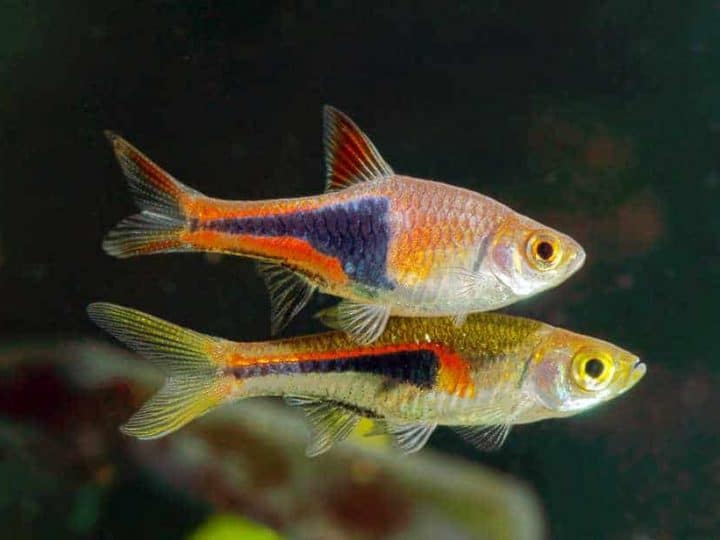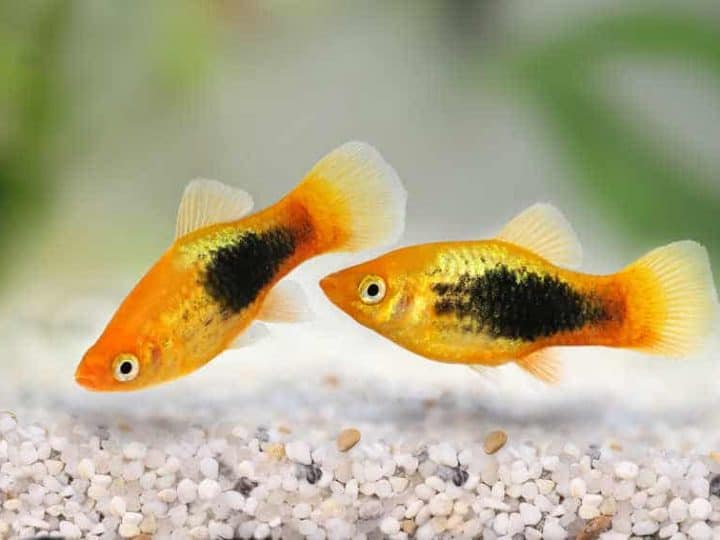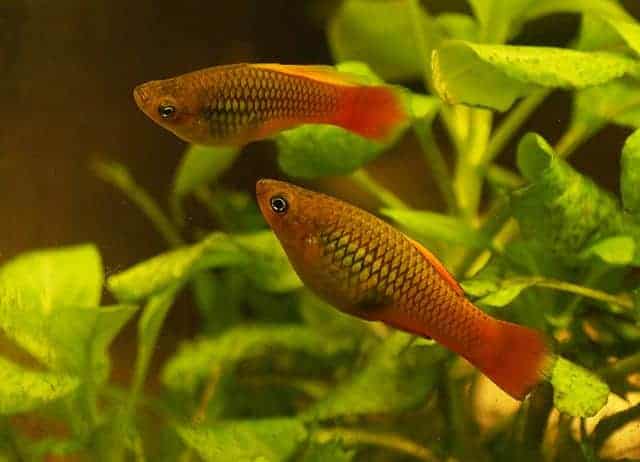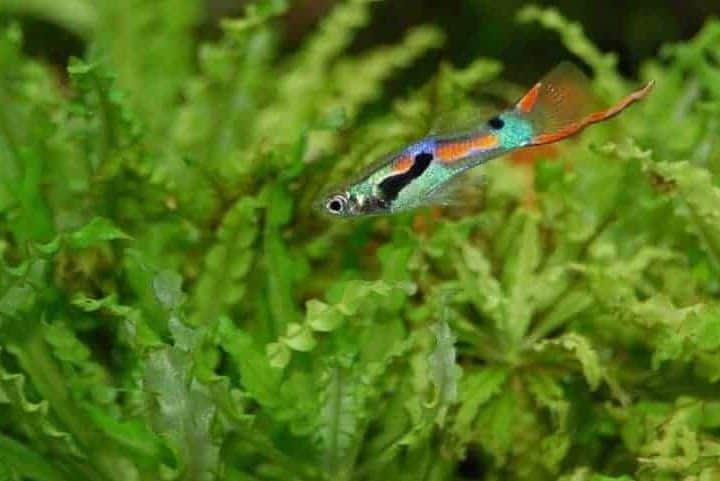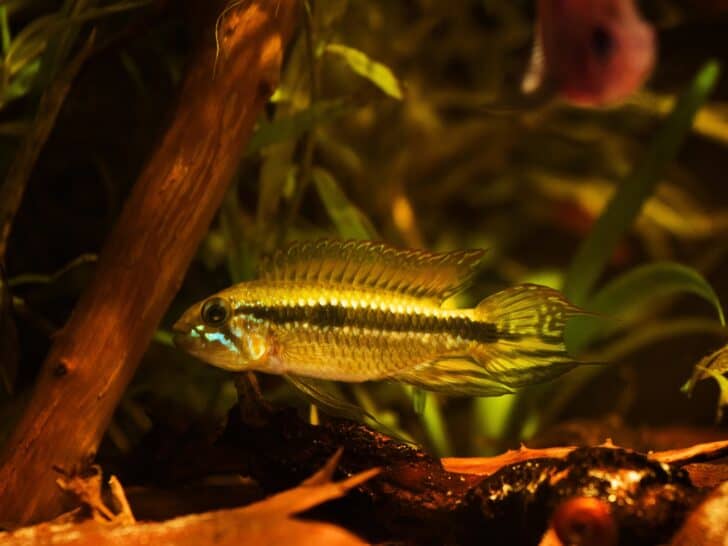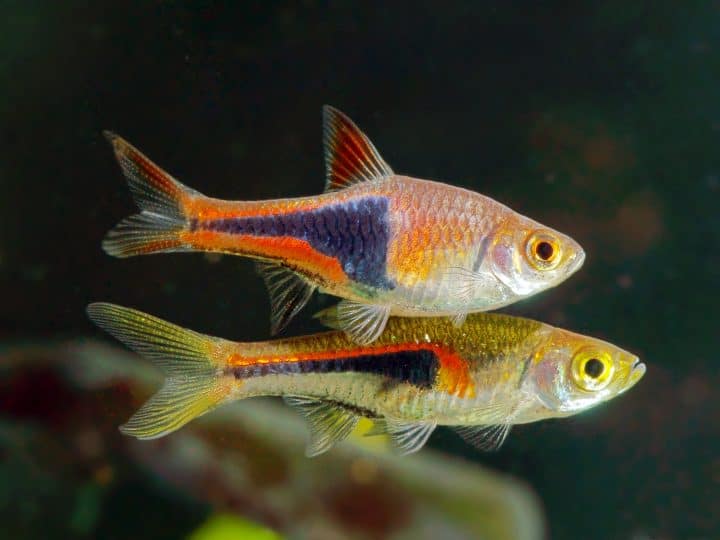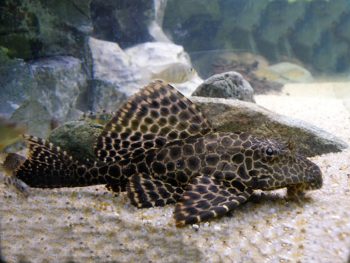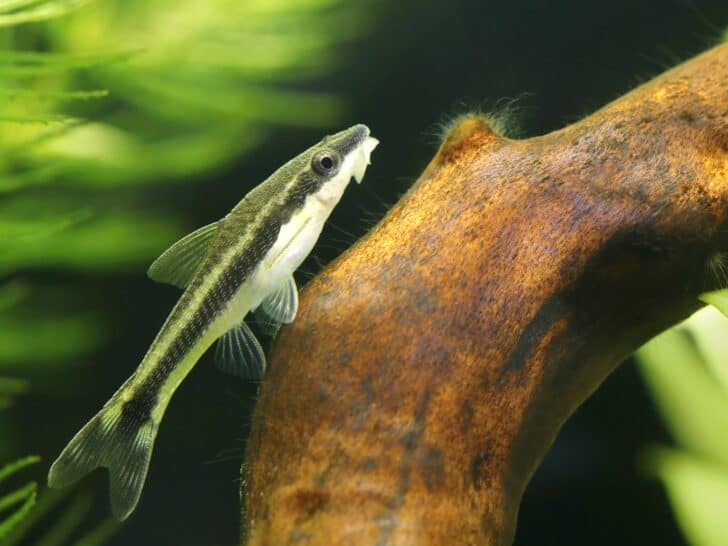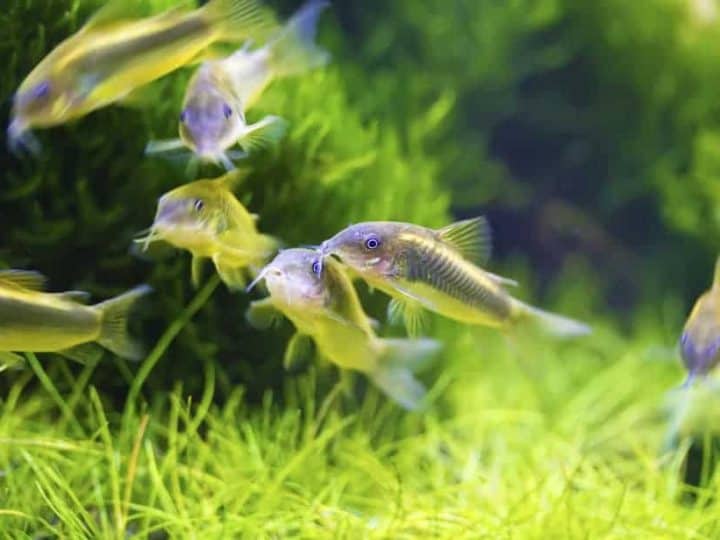Not all aquarium fish are suitable for planted tanks, but there are also many that are. So, what are the best aquarium fish for planted tanks and aquascaping.
Some of the best aquarium fish for planted tanks and aquascaping, including cardinal tetras, harlequin rasboras, otocinclus catfish, gouramis, angelfish, and corydoras, among others.
I’ll make sure that you’ve got some ideas of fish that do well in a planted tank. I will also warn you against some of the more common bad options that might ruin your aquascape.
What makes an aquarium fish suitable for a planted tank?
Before we dive into the list of suitable fish, it’s important to know what makes a fish suitable for a planted aquarium.
Aquarium fish in a planted tank should not eat or destroy your live plants. That’s honestly the main thing to look out for. I can stretch this information as long as I want, but the truth is to stay away from larger fish like goldfish, cichlids, silver dollars, larger catfish and loaches. Later in the article I’ll talk a bit more about the reasons to stay away from these fish, but in general the reason is because they will rip apart your aquarium.
A suitable aquarium fish for a planted tank is small and will do no harm to any of your plants. Sure, the fish are allowed to eat algae from the surface of the plants, but all the healthy leaves should remain untouched.
If you’re going all out and create an aquarium with a primary focus on the plants, you want to add timid fish that do not distract too much from the greenery. I’ll attach a picture of my Dutch style aquascape for which I’m trying to find suitable fish below. In my case, I want to add small fish to make the aquarium seem larger.
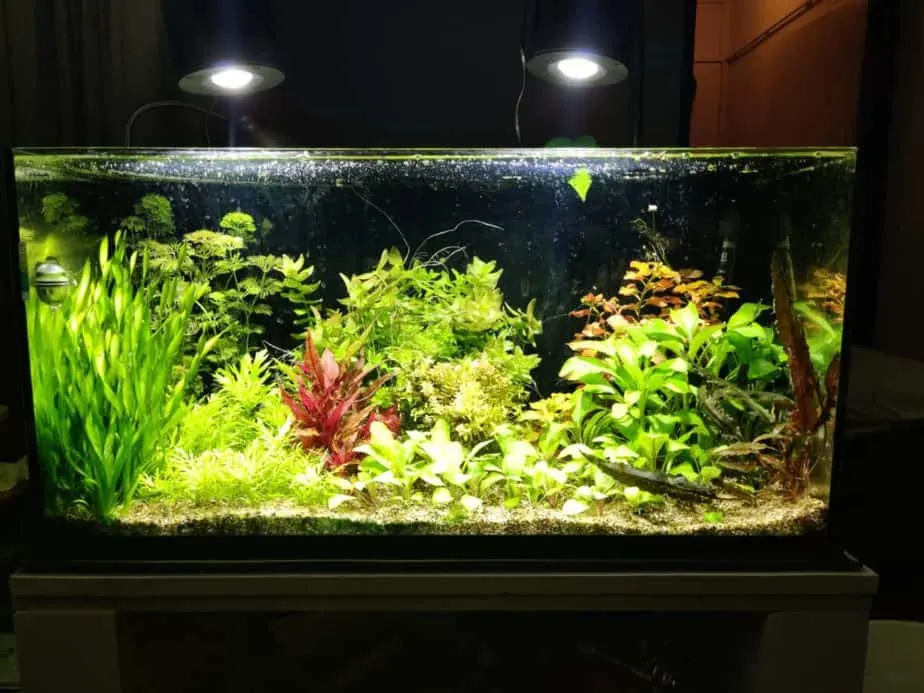
Many planted tank enthusiasts agree that every planted aquarium needs a group of schooling fish. I’d agree, because a school of fish will add to the beauty of the tank without distracting the viewer or damaging the plants.
When it comes to a Dutch Style Aquascape, like the one pictured above, there are rules about what fish should be in the tank. The rule says that every layer of the aquarium should have inhabitants. There should be top-dwellers like gourami’s or killifish, mid-dwellers like tetras or rasboras and finally there should be some bottom-dwelling fish like corydoras.
1. Cardinal Tetras
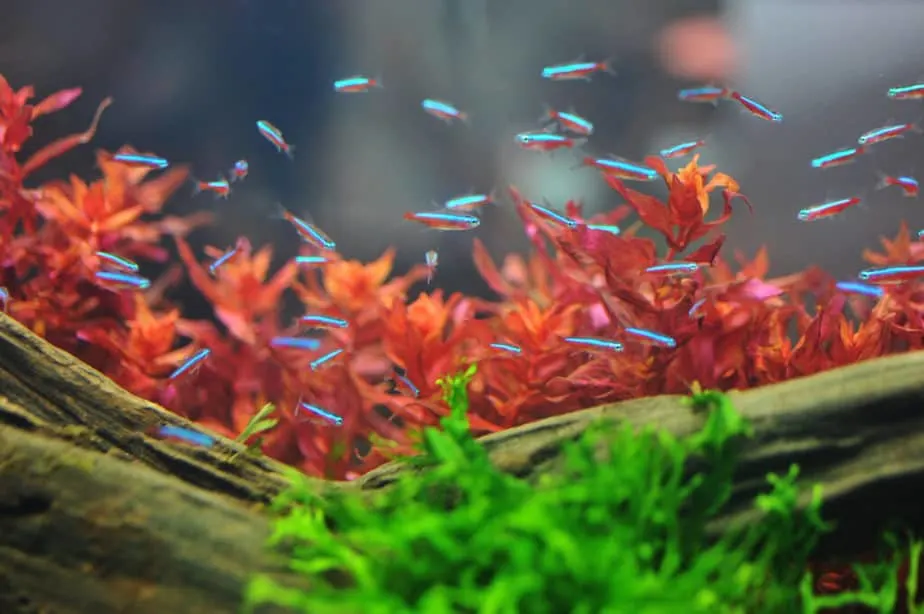
The most widely recognized schooling fish is the cardinal tetra, and they are extremely suitable for planted tanks. I understand if you find they a bit boring or cliché, so I promise I’ll add some more uncommon fish further down the list.
Cardinal tetras are colorful and rather shy, but in a group find courage to swim around among the plants. Their color adds so much to the look of your aquarium that I guarantee you’ll like it. The blue looks like bright LED lights. If you add a group of 10 or more cardinal tetras to your planted tank you’ll not be disappointed, as they are very peaceful fish, (as are white cloud mountain minnows).
I’m starting to sound like a salesperson here, so I’ll turn it down a notch. The reason why I decided to put these fish on top of this list is because I’m thinking of adding a school of these fish (or neon tetras if I’m feeling bold) to my Dutch style aquascape.
2. Harlequin Rasboras
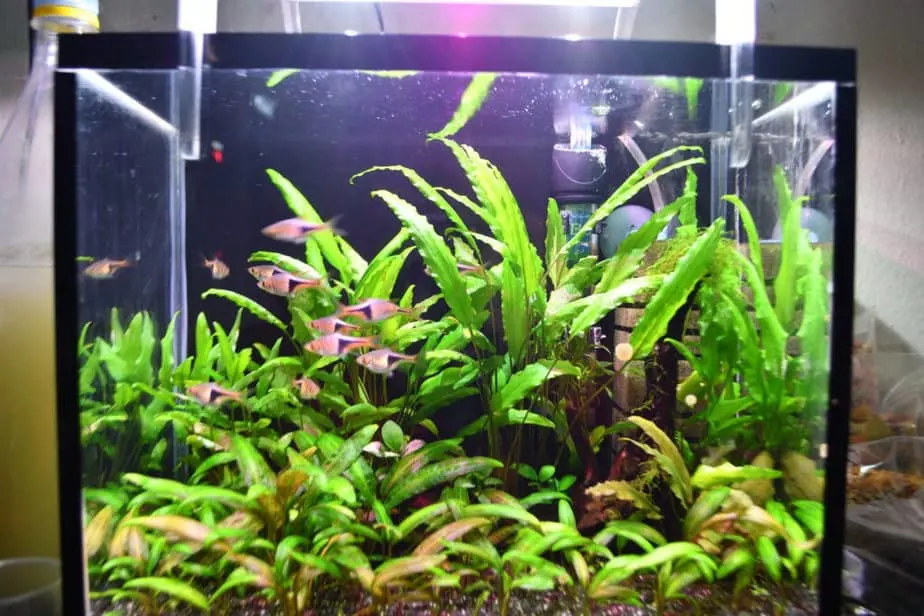
The second fish on this list is another schooling fish, so I’ll make sure that the next one isn’t. On number two I put another classic: the harlequin rasboras. They’re often also called porkchop rasboras due to the black porkchop shape. If you do want to keep these beautiful fish, make sure to give them a little more space than on the picture I found online.
These schooling fish are extremely peaceful and will make a great addition to any planted tank. In my opinion their colors add a balanced and natural look to the tank that does not immediately grab your attention. In case of real planted tanks I would say this can be a good thing if you want to keep focusing on the plants. I’ve said this a couple of times already so I’m sure that the rest of the explanations will be a bit more brief.
If you end up buying a school or shoal of these fish, make sure to keep at least 5 of them at the same time. If the school is larger, they’ll feel more at ease and will behave in a more natural way.
3. Otocinclus Catfish
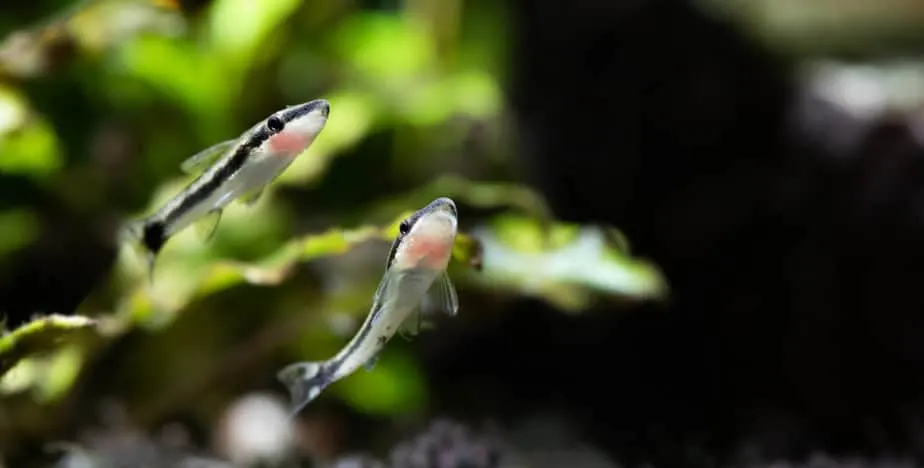
I feel like I could have put these fish all the way at number one, because they’re a great addition to a planted tank. The reason for this is because otocinclus are great algae eaters and therefore help keep your planted tank clean. In fact, these fish were the first fish I added to my Dutch Style Aquascape that I showed before.
These fish show awesome behavior and in my opinion have great personality. They’re cute and always busy. They do in fact eat a lot of algae, but from experience I can tell you that they do not eat all kinds of algae. Green hair algae is a type which they don’t eat (at least mine did not).
Otocinclus prefer to live in a group of at least 5 fish. Make sure to get several of them to make them feel at ease. You can feed them sinking algae wafers, but they’ll also gladly eat cucumber, zucchini or blanched lettuce.
4. Gourami fish
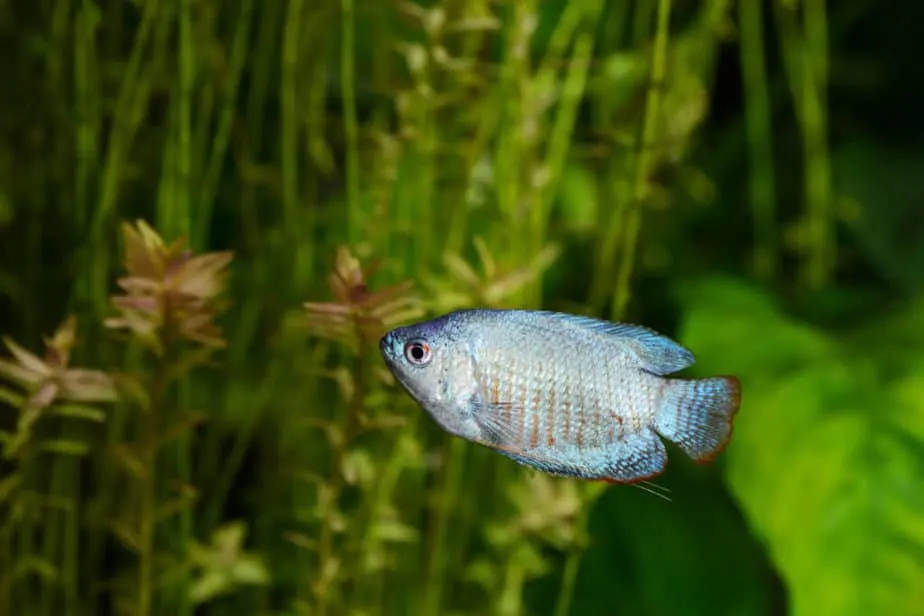
Moving to the first real centerpiece or display fish on this list: gouramis. These beautiful fish will grab your attention because they look amazing. There are many different kind of gouramis, of which many are available in your local fish store.
Common gouramies that are popular in the hobby include the Pearl gourami, Honey gourami, Dwarf gourami, Opaline gourami, Blue gourami and even the Kissing gourami. That last one, the kissing gourami, might become too large and could cause problem in a planted tank.
If you’d like to keep a gourami fish in your planted tank, make sure to add a lid to your aquarium. These fish are phenomenal jumpers and you do not want them to fall all the way to the floor. Also, it’s best to keep either two females or one male and one female. Two male gouramies can become aggressive.
My favorite fishtank products that make life easier
I am so happy you enjoy this post so far! You will also definitely like my product recommendations that will make your fishkeeping experience so much better. I’m 100% sure you’ll love them!
- Without a gravel vacuum, like one from Aqueon, cleaning the substrate of your tanks is near impossible. Whenever I want to remove some of the sunken detritus from the bottom of my acrylic tanks I’m happy I’ve got one of these.
- It’s no secret that I do not like nutritious aqua-soil. It makes a mess and only works for a given amount of time. Instead, I always use a liquid aquarium plant fertilizer. Everyone who keeps live plants needs it, it’s not that expensive and makes your plants grow better.
- I love keeping plants, but planting and reorganizing my aquarium was difficult until I got a set of these tools. It’s much easier to plant any kind of plant compared to using my thick fingers.
- Ever since I’m able to accurately test my water parameters, including the pH level, keeping fish became less stressful. Before I was always stressed that my water parameters were wrong, but with a kit such as the API Master kit, I can measure this. It really is essential to successful fishkeeping.
- The more you know about your aquarium, the better! Temperature is crucial for the health of your fish. A thermometer will also show you whether your heaters are still working correctly. It will give you more insight and more peace of mind. It’s an easy way to ensure that you’re providing your fish with the tropical temperatures they need.
5. Shrimp
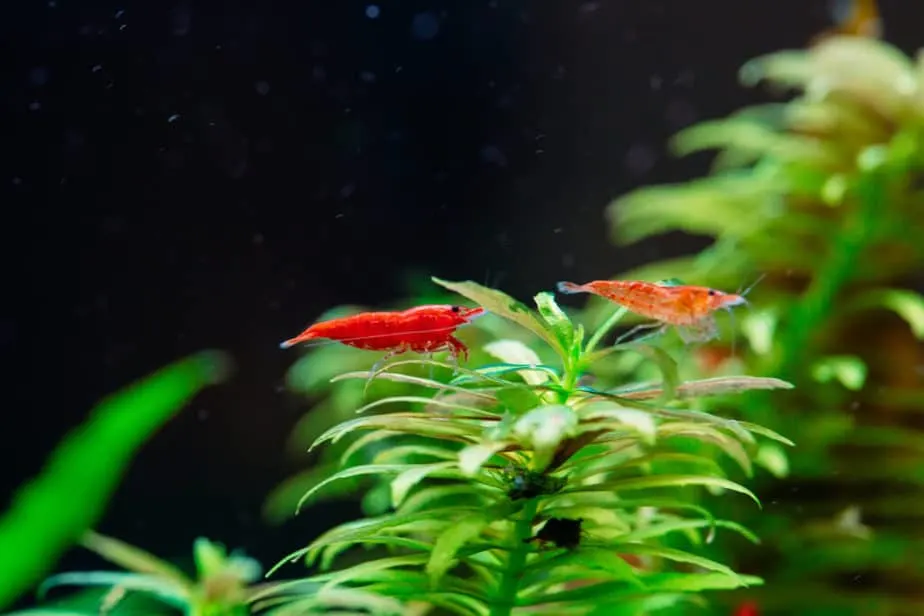
Another great addition to your planted tank could be shrimp! I know that they can not really be considered fish, but you should welcome them with open arms. I’d recommend neocaridina shrimp, they come in many colors and breed in your tank.
I am keeping orange neocaridina shrimp called “sakura shrimp” and they breed really quick. They also help keeping your planted tank clean, which comes in handy if you’re trying to battle algae.
Freshwater aquarium shrimp can be a little expensive, so it is important to check whether the rest of the fish that you are keeping are suitable for shrimp. Larger fish, even schooling fish, like to hunt and eat shrimp. This is not something you’d want if you’ve just paid over 2 bucks per shrimp, so only add shrimp to your aquarium if the situation allows it.
If you’re in doubt, send me a message of ask someone else with experience to advice you.
6. Livebearers Such as Guppies or Mollies
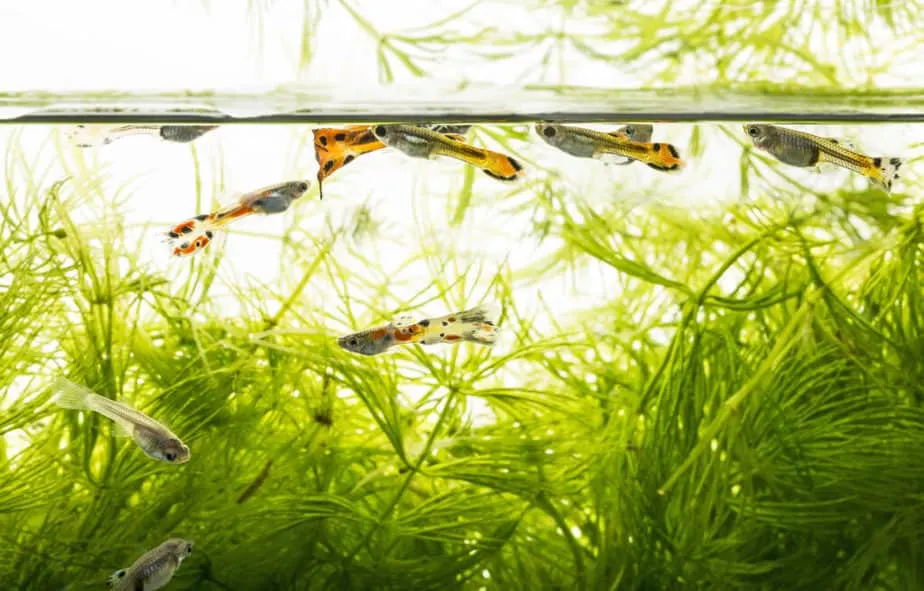
All livebearers deserve a spot on this list, because keeping livebearers in a planted tank is convenient and rewarding. They’re peaceful and have no interest in your healthy plants. Next to being suitable in combination with plants, they’re always breeding! This means that you’ll always have fry growing up in your aquarium, which is just lovely to see.
There’s not much more to say about livebeares because they’re that easy. The only thing you should know before buying any is to always buy 3 females for every mail that you get. The 1:3 male to female ratio makes sure that no female fish experiences stress cause by too much male attention.
If you’re keeping other larger fish in your aquarium, for example one or two gouramies, it becomes difficult for the fry to survive. If you provide enough hiding places by adding moss or floating plants, the chance that your baby fish survive increases.
7. Corydora Catfish
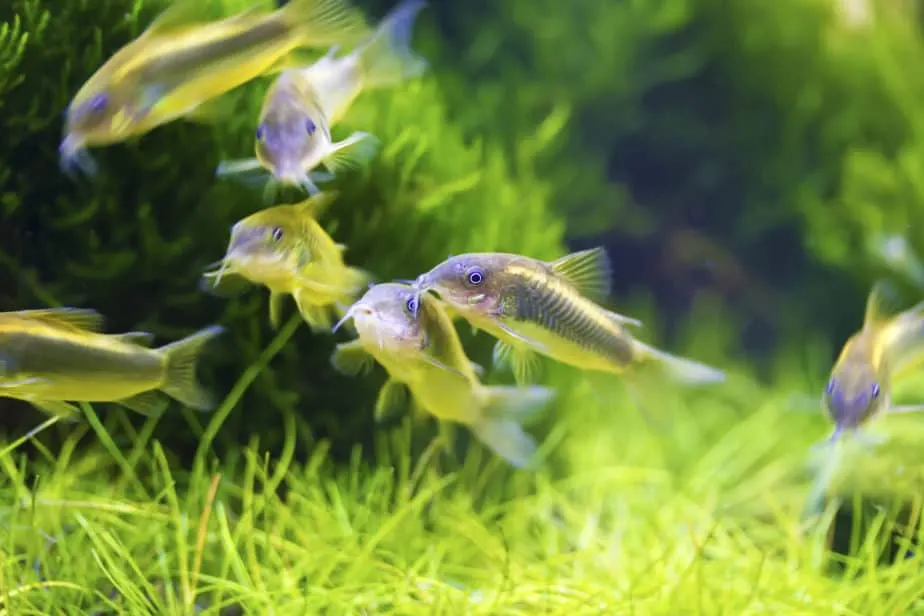
If you remember from earlier, I explained that in official Dutch Style Aquascape competition rules there should be fish in all layers of your planted tank. These layers are also relevant if you’re not welcoming a judge into your home to sit in front of your tank for 45 minutes.
Finding fish for the bottom layer of your planted tank can be daunting. Chances are that you’ve got a carpet of plants going on, so any digging is out of the question. While corydoras do enjoy scavenging the substrate for food, they’ll never cause enough “damage” to uproot plants. They’re the perfect planted tank bottom dwellers.
Something that many people tend to forget is that corydoras are in fact a schooling fish. Always keep them in a group of 5 fish or more to make them feel comfortable. They’ll really start showing signs of stress if you keep any less. Furthermore, their behavior is much more energetic and truly fascinating to look at in a group.
There are many different varieties of corydoras. I would stick with some of the smaller variants such as the panda cory, the habrosus cory or the bronze corydoras. These smaller fish will make the rest of your aquarium, or rather the aquarium as a whole, look larger.
8. Snails
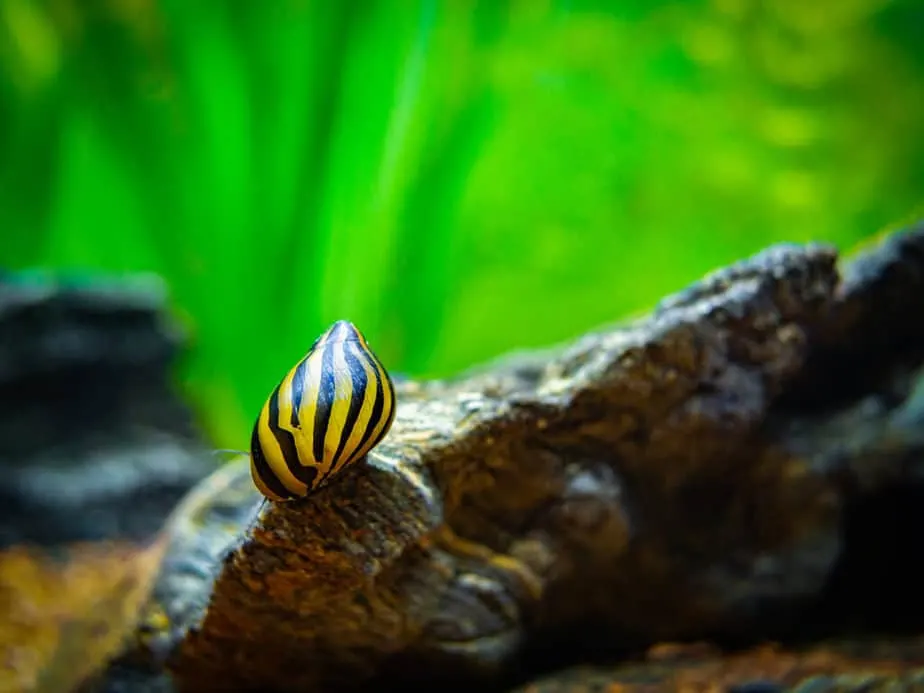
You either love these little invertebrates or you hate them, but you can not deny the benefits of keeping snails in your planted tank. Snails are great at eating algae and finding uneaten food, and they can be found at virtually all pet stores. This is relevant for a normal aquarium, but even more relevant for a planted tank. Snails will be able to reach places that you and your gravel vacuum just can not reach.
I do understand that many people do not want to deal with an ever growing snail population, so there are some tips I want to give you to prevent this. First of all, the best algae eaters out there are Nerite snails (like the one on the picture above). Nerite snails can not reproduce in a freshwater aquarium, so you’ll never have to worry about an infestation.
Other snails, like pond snails, Malaysian trumpet snails or ramshorn snails are great to have in your tank. They can also serve as an indicator for overfeeding. If their population starts to grow too fast, it means that you’re feeding to much. Just reduce the amount of food you’re adding to the tank and your problem will be solved.
And if you really want to reduce the size of the population, add some assassin snails or catch them overnight with a piece of cucumber. It really is not that difficult.
9. Angelfish
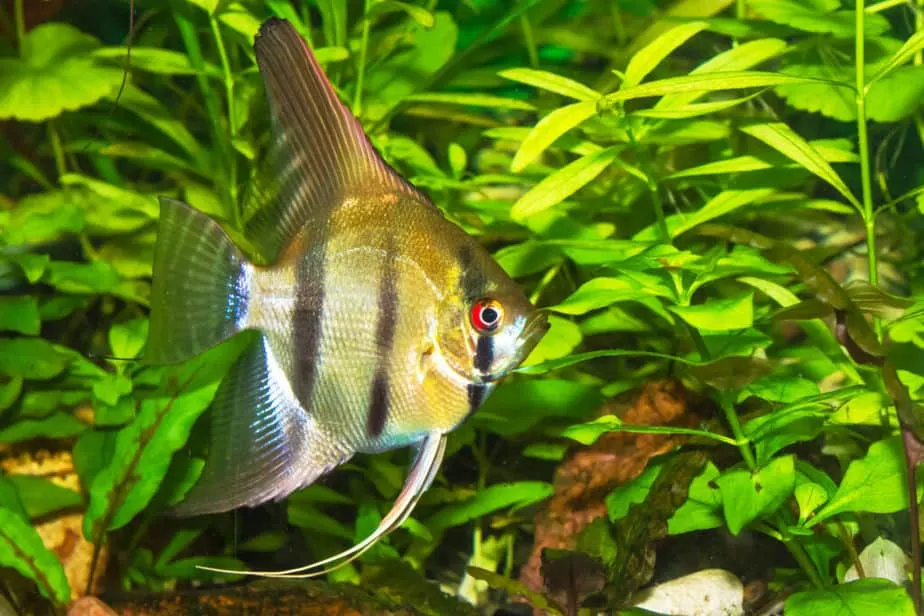
Up until now all the fish on the list have been rather small. If you want to keep some large and stunning fish that do well in a planted tank, angels might be for you. These fish can become very large (especially when it comes to height) so they need a larger aquarium. For specific measurements you’ll have to do some research, because just the info underneath this image will not be enough.
These fish are great and are known to be beautiful centerpiece fish in large planted tank. If you keep them in a tank with plants like vallisneria, amazon swords and java fern they’ll be over the moon. In fact, I’ve written an entire article on my website dedicated to plants that are suitable for angelfish. It’s called “11 Best Aquarium Plants for Angelfish” and I highly recommend reading it before buying your first angelfish.
10. Bleeding Heart Tetras
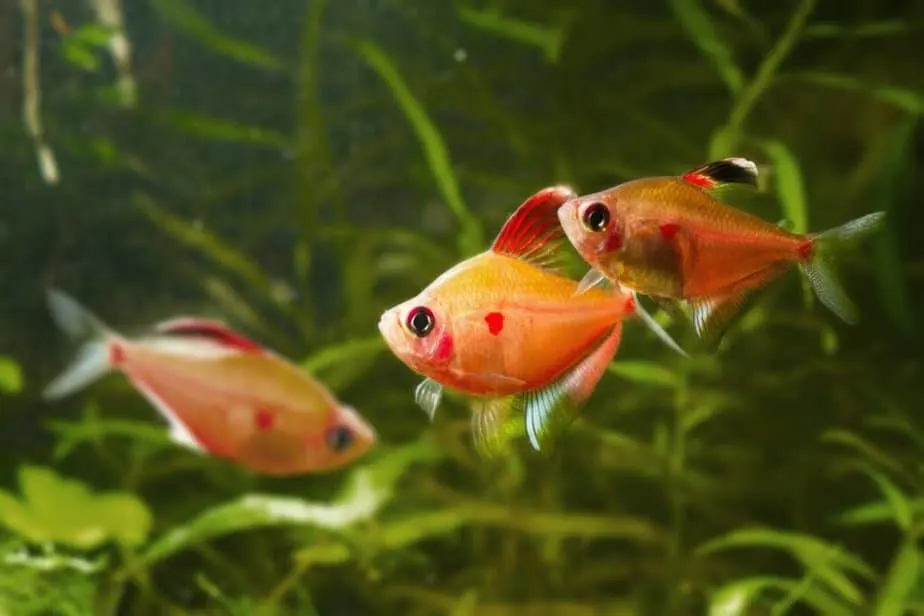
The final fish on this list represent a group or larger tetras, also containing the bleeding heart tetra. If larger planted tank you’re most likely going to want a school or larger fish. After some research I would definitely settle on a tetra, but which one.
There’s bleeding heart tetras, which you can see on the picture above. They are super pretty and will work great in a planted aquarium. Some alternatives that have rougly the same “requirements” are congo tetras, rummynose tetras, ember tetras and redeye tetras. Personally my favorites are redeye tetras. They’re super calm and relaxed, and their natural colors are perfect in a beautiful planted tank.
What Fish to Avoid in a Planted Aquarium
I would briefly like to explain a little bit more about the fish that you should avoid when you’re looking for fish that are suitable for a planted tank. The first group of fish that you should not add to any planted tank are cichlids. Cichlids are large fish that will decide by themselves how they want to arrange their tank. A planted tank will be destroyed within days by dwarf cichlids.
Also, stay away from goldfish. While these fish are super popular, they do tend to try and dig a hole so deep it can reach the other side of the planet. They won’t leave any rooted plants where they were, whether java moss or otherwise, so they’re not very suitable for a planted tank.
Third on this list are discus fish. While discus fish don’t destroy planted setups, their requirements might be a little too extreme for most common plants to grow. Discus fish need to be kept at a high temperature at which most plants don’t feel comfortable anymore. I’ve written a super popular article on my site where I cover a list of plants that you can use in combination with discus fish in your aquarium hobby. You can read that here on my website.
Finally, don’t add any large or aggressive fish to your planted tank if you want to keep your aquascape the way you designed it. Be smart, and if in doubt ask someone with experience. If you don’t know anyone personally, hop online and join a community where you can ask your question.
What’s the Benefit of Having a Planted Tank?
You might think that using fake plants is easier, but the fact is that having real and live plants in your fish tank can make a big difference. So, why is this the case?
- Live aquarium plants can help to sequester carbon dioxide, thus making a fish tank more inhabitable for fish and other aquatic creatures.
- The beneficial bacteria that can grow on plants can be useful for reducing ammonia, nitrate, and other water contaminants. It’s all about the nitrogen cycle!
- Fish, whether the white cloud minnow or cherry barbs, all love plants, and it’s because of one simple reason, they help to mimic their natual habitat.

